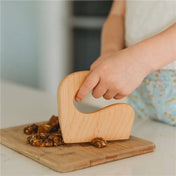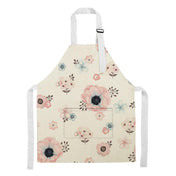Wooden Blocks - Your Complete Guide
Wooden toys seem to last almost forever, with many well-loved favourites passed down from generation to generation.
Wooden building blocks, in particular, are a classic addition to any playroom. These traditional and durable toys not only allow your child’s imagination to run free, but have also been proven to improve spatial awareness, improve motor skills, and cognitive flexibility.
Here at My Happy Helpers, we pride ourselves on providing families with durable, long-lasting, practical and purposeful wooden blocks for the little boys and girls of Australia.
Wooden blocks allow children's imaginations to run free and build their own world. As children create with block sets, they learn to see the world through different eyes. Simple, versatile and created especially with boundless imaginations in mind, they are the perfect tool for learning and playing.
By giving your child wooden blocks, boys and girls can both learn to build whatever inspires them.
At what age should my child start playing with wooden blocks?
Wooden block sets are ideal for boys and girls of any age, but we recommend introducing them into the playroom when your child is six months old.
Here’s what you can expect from your child’s interaction with wooden building blocks at each age:


3 Years
What are the benefits of wooden blocks for kids?
Many studies agree that young children learn and develop by interacting with objects in their environment.
Wooden blocks may seem like a simple toy, but these multi-purpose blocks will introduce a number of concepts to your child, such as:
- Motor skill development
- Hand-eye coordination
- Spatial awareness and reasoning
- Cognitive flexibility
- Structural integrity
- Physical balance
- Engineering skills
- Visual harmony and creative thinking
How do building blocks help my child’s development?
As we stated above, there are many ways in which wooden building blocks can benefit your child, helping them develop their social, visual, physical, intellectual and cognitive skills.
But how does it work? Obviously, your little one can learn about size, shape and colour simply by handling wooden blocks but do they actually develop higher skills?

Spatial Reasoning
Cognitive Flexibility
Language Development
Problem-Solving
Engineering Skills
How can I play with building blocks with my kid?
While it’s great to find a toy that kids can play with by themselves, it’s also been proven that children thrive when they are able to play together with a parent.
Wooden block sets are the perfect vessel for play-time with your son or daughter, and there are plenty of things you can do to enhance block play.
- Lead by example: Engage your child in spatial talk and show them how to play with the blocks. Build structures for them and show them how to do it themselves.
- Encourage building projects: Some children may be shy with others, but building blocks are a great way to break the ice! Encourage your children to play with others and build something together.
- Develop specific tasks: While free-play is important, your kid can also learn by mimicking. Suggest a type of structure to build either by constructing your own or giving your child pictures and diagrams and encourage them to match what you’ve made.
- Indulge the imagination: Fantastic is a crucial component of play, and while wooden toy blocks may seem like a very grounded toy, they can also be improved by imaginative elements like story time, and accessory toys like people, animals and cars.
Are wooden blocks safe?
Wooden blocks for kids are incredibly safe! Not only are wooden toys environmentally friendly, but they also break down in landfill without any need for hazardous toxins.
One thing to keep in mind when purchasing wooden toys, or using hand-me-downs, is to be sure that they are not coated in lead-based paint.
My Happy Helpers independently tests all of our wooden toys for lead particles to ensure they are safe for even your littlest babes.
How do I clean wooden blocks?
Has your child been chewing on their wooden toy blocks? Or may they’ve just gone through a bit of wear and tear.
Never fear, cleaning your wooden blocks is easy. Because these toys are made of wood, we do not recommend soaking them in water.
However, you can easily clean them by wiping them with a wet cloth and a little bit of mild soap. Just make sure to dry the blocks thoroughly before returning them to your child.
What are the most popular types of building blocks?
There are many different types of wooden blocks, and each has its own uses. Here are a few of the most popular styles in Australia:
- Alphabet Building Blocks
- Magnetic Building Blocks
- Rainbow Building Blocks
- Interlocking Building Blocks
- Castle Building Blocks
- Building Blocks For Crafts
- Sound Building Blocks
What to consider when buying wooden toys for your kids
When deciding what’s suitable for your family, there is no right or wrong. The best choice you can make for your child is to select toys that are safe and appropriate for his or her age and development.
Select toys that you can afford, and most importantly, always read what your toys are made of and routinely inspect your toys for loose parts or sharp edges to avoid choking hazards and injury.
We strongly believe that all families deserve to have safe, durable and affordable products to spark their children’s curiosity and play in and discover the environment around them.
Our children's wooden toys are educational, great fun, safe and excellent quality.
Discover building blocks galore
My Happy Helpers’ building block for kids’ range is filled with gorgeous colours, finishes and characters to capture little ones’ imaginations. They will love the beautiful shapes and learning about patterns as they play with their building blocks, which will without a doubt become treasured playtime pals.
We have the best baby building blocks to choose from
Our baby building blocks offer bright shapes and building block toys for first-time explorers.
Whether they play with staking toys or square blocks, little ones will enjoy the thrill of each playtime session with their baby building blocks offers.
Our weighted building blocks offer amazing sensory discoveries too, making them ideal for all ages, from younger to older toddlers alike.
Building block toys that will inspire little ones’ creative sides
My Happy Helper’s building block toys options include small world play too – a perfect activity for when little ones are ready to start developing their fine motor skills through fun, educational play.
These building block toys include castle and fairy tale sets designed with non-toxic materials to make them safe for little ones to play with. They will love giving personality to their characters and to tell you all about their magical adventures!
Building blocks for kids that will inspire learning with every playtime
Our arches and puzzles are perfect for older toddlers who love problem-solving building block toys that allow them to figure out age-appropriate clues to solve how their favourite building blocks and arches fit in together. Our extensive range of wooden blocks will also encourage and inspire your little ones imagination.
Safe materials, for great building blocks fun
Building block toys should be all about fun and worry-free play, which is why we take exceptional care to only use child-friendly materials to produce our toys.
Rest assured, mum and dad, your little ones can enjoy their building block toys to the full and have hours of play to help them make the most of their playsets.
If you are looking for wooden building blocks for your infant or kids in Australia, we have a great range available. Browse our selection of wooden blocks, and remember to take lots of photos, savour every moment and live life to its fullest!




